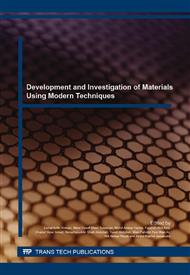[1]
S. Nalinanon, S. Benjakul, W. Visessanguan, H. Kishimura, Use of pepsin for collagen extraction from the skin of bigeye snapper (Priacanthus tayenus), Food Chem. 56 (2007) 37–48.
DOI: 10.1016/j.foodchem.2006.12.035
Google Scholar
[2]
A.A. Karim, R. Bhat, Fish gelatin: properties, challenges, and prospects as an alternative to mammalian gelatins, Food Hydrocoll. 23(2009) 563–576.
DOI: 10.1016/j.foodhyd.2008.07.002
Google Scholar
[3]
I. Ratnasari, S.S. Yuwono, Chew, H. Nusyam, S.B. Widjanarko, Extraction and characterization of gelatin from different fresh water fishes as alternative sources of gelatin, Int. Food Res. J. 20 (2013) 3085–3091.
Google Scholar
[4]
N.M. Nik Aisyah, H. Nurul, M.E. Azhar, A. Fazilah, Poultry as an alternative source of gelatin, Health and The Env. 5 (2014) 37–49.
Google Scholar
[5]
T. Rustad, Utilisation of marine by-products, Elec. J. Env. Agricult. Food Chem. 2 (2003) 458–463.
Google Scholar
[6]
M.C. Gomez-Guillen, J. Turnay, F.D. Fernandez-Diaz, N. Ulmo, M.A. Lizarbe, P. Montero, Structural and physical properties of gelatin extracted from different marine species: a comparative study, Food Hydrocoll. 16 (2002) 25–34.
DOI: 10.1016/s0268-005x(01)00035-2
Google Scholar
[7]
K. Shyni, G.S. Hema, G. Ninan, S. Matthew, C.G. Joshy, P.T. Lakshmanan, Isolation and characterization of gelatin from the skins of skipjack tuna (Katsuwonus pelamis), dog shark (Scoliodon sorrakowah), and rohu (Labeo rohita), Food Hydrocoll. 39 (2014).
DOI: 10.1016/j.foodhyd.2013.12.008
Google Scholar
[8]
M. Gudmundsson, Rheological properties of fish gelatins, J. Food Sci. 67 (2002) 2172–2176.
DOI: 10.1111/j.1365-2621.2002.tb09522.x
Google Scholar
[9]
L. Niu, X. Zhou, C. Yuan, Y. Bai, K. Lai, F. Yang, Y. Huang, Characterization of tilapia (Oreochromis niloticus) skin gelatin extracted with alkaline and different acid pre-treatments, Food Hydrocoll. 33 (2013) 336–341.
DOI: 10.1016/j.foodhyd.2013.04.014
Google Scholar
[10]
N. Jamilah, K.G. Harvinder, Properties of gelatins from skins of fish-black tilapia (Oreochromis mossambicus) and red tilapia (Oreochromis nilotica), Food Chem. 77 (2002) 81–84.
DOI: 10.1016/s0308-8146(01)00328-4
Google Scholar
[11]
J. Irwandi, S. Faridayanti, E.S.M. Mohamed, M.S. Hamzah, H.H. Torla, Y.B. Che Man, Extraction and characterization of gelatin from different marine fish species in Malaysia, Int Food Res J. 16 (2009) 381–389.
Google Scholar
[12]
S. Grossman and M. Bergman, Process for the production of gelatin from fish skins U.S. Patent 5, 093, 474. (1992).
Google Scholar
[13]
M. Gudmundsson and H. Hafsteinsson, Gelatin from cod skins as affected by chemical treatments, J. Food Sci. 62 (1997) 37–39.
DOI: 10.1111/j.1365-2621.1997.tb04363.x
Google Scholar


